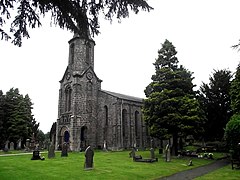Buglawton
| Buglawton | |
|---|---|
 St John's Church | |
Location within Cheshire | |
| Civil parish | |
| Unitary authority | |
| Ceremonial county | |
| Region | |
| Country | England |
| Sovereign state | United Kingdom |
Buglawton is a suburb of Congleton, in the Cheshire East district of Cheshire. It was a parish and an urban district (i.e. effectively an independent town) from 1894 until 1936.
The Urban District Council consisted of six elected members and five officers, the latter including a council clerk, a surveyor and a rate and rent collector.[1] The council was responsible for quite a large geographical area, greater in size than the borough of Congleton at that time though smaller in population and in buildings. Most of the 2580 acres which comprised the parish of Buglawton was used for dairy farming and the Council's area was generally more rural than industrial. The bulk of the population, however, lived and worked in a small area adjacent to the River Dane.[1] The parish church of St John was built in 1841.

The area of the former parish includes the hamlets of Timbersbrook, Key Green, Crossley and Havannah plus the Cheshire side of the Cloud.
Buglawton was formerly a township and chapelry in Astbury parish;[2] in 1866 Buglawton became a separate civil parish; in 1984 Buglawton became an urban district; on 1 April 1936 the parish and urban district were abolished and merged with the Municipal Borough of Congleton.[3] In 1931 the parish had a population of 1651.[4]
Etymology
[edit]The name "Buglawton" means 'boggart's hill farm', the prefix to distinguish from Church Lawton.[5]
Notable residents
[edit]23 Buxton Road, Buglawton was the residence of Elizabeth Clarke Wolstenholme Elmy from 1874 to 1918 and a Blue Plaque was erected there for her by the Congleton Civic Society; it reads, "Elizabeth Wolstenholme-Elmy 1839-1918 Campaigner for social, legal and political equality for women lived here 1874-1918". Benjamin Elmy founded the Male Electors' League for Women's Suffrage in 1897, the first all male society to specifically campaign for women to have the vote.[6] Elmy's son, Frank Elmy was elected to the Urban District Council in 1904 and was employed as assistant overseer and rate collector for Buglawton Urban District Council.[7]
See also
[edit]References
[edit]- ^ a b Kenny, J. (1979). Congleton, Changing Times. Keele up. p. 53.
- ^ "History of Buglawton, in Congleton and Cheshire". A Vision of Britain through Time. Retrieved 18 March 2022.
- ^ "Relationships and changes Buglawton CP/Ch through time". A Vision of Britain through Time. Retrieved 18 March 2022.
- ^ "Population statistics Buglawton CP/Ch through time". A Vision of Britain through Time. Retrieved 18 March 2022.
- ^ "Buglawton Key to English Place-names". The University of Nottingham. Retrieved 18 March 2022.
- ^ Elizabeth Wolstenholme Elmy and the Victorian Feminist Movement by Maureen Wright p163
- ^ Elizabeth Wolstenholme Elmy and the Victorian Feminist Movement by Maureen Wright p211
External links
[edit]- [1] - Buglawton Primary School

